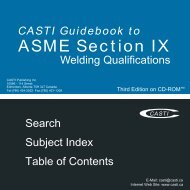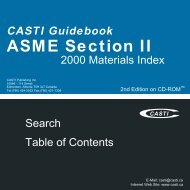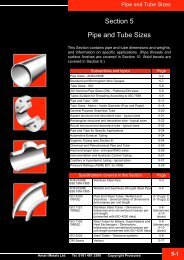Welded Steel Tanks for Oil Storage
Welded Steel Tanks for Oil Storage
Welded Steel Tanks for Oil Storage
- No tags were found...
You also want an ePaper? Increase the reach of your titles
YUMPU automatically turns print PDFs into web optimized ePapers that Google loves.
3-10 API STANDARD 650<br />
If the value of the ratio is greater than 1.375 but less than<br />
2.625,<br />
t 2 = t 2a + ( t 1 – t 2a ) 2.1 – -------------------------<br />
1.25( rt 1 ) 0.5<br />
where<br />
t 2 = minimum design thickness of the second shell course<br />
excluding any corrosion allowance, in mm (in.),<br />
t 2a = thickness of the second shell course, in mm (in.), as<br />
calculated <strong>for</strong> an upper shell course as described in<br />
3.6.4.6.<br />
The preceding <strong>for</strong>mula <strong>for</strong> t 2 is based on the same allowable<br />
stress being used <strong>for</strong> the design of the bottom and second<br />
courses. For tanks where the value of the ratio is greater<br />
than or equal to 2.625, the allowable stress <strong>for</strong> the second<br />
course may be lower than the allowable stress <strong>for</strong> the bottom<br />
course when the methods described in 3.6.4.6 through<br />
3.6.4.8 are used.<br />
3.6.4.6 To calculate the upper-course thicknesses <strong>for</strong> both<br />
the design condition and the hydrostatic test condition, a preliminary<br />
value t u <strong>for</strong> the upper-course thickness shall be calculated<br />
using the <strong>for</strong>mulas in 3.6.3.2, and then the distance x<br />
of the variable design point from the bottom of the course<br />
shall be calculated using the lowest value obtained from the<br />
following<br />
In SI units:<br />
x 1 = 0.61 (rt u ) 0.5 + 320 CH<br />
x 2 = 1000 CH<br />
x 3 = 1.22 (rt u ) 0.5<br />
where<br />
t u = thickness of the upper course at the girth joint,<br />
in mm,<br />
C = [K 0.5 (K – 1)]/(1 + K 1.5 ),<br />
K = t L / t u ,<br />
t L = thickness of the lower course at the girth joint,<br />
in mm,<br />
H = design liquid level (see 3.6.3.2), in m.<br />
In US Customary units:<br />
x 1 = 0.61 (rt u ) 0.5 + 3.84 CH<br />
x 2 = 12 CH<br />
x 3 = 1.22 (rt u ) 0.5<br />
where<br />
t u = thickness of the upper course at the girth joint, (in.),<br />
C = [K 0.5 (K – 1)]/(1 + K 1.5 ),<br />
K = t L / t u ,<br />
t L = thickness of the lower course at the girth joint, (in.),<br />
H = design liquid level (see 3.6.3.2), (ft),<br />
h 1<br />
3.6.4.7 The minimum thickness t x <strong>for</strong> the upper shell<br />
courses shall be calculated <strong>for</strong> both the design condition (t dx )<br />
and the hydrostatic test condition (t tx ) using the minimum<br />
value of x obtained from 3.6.4.6:<br />
In SI units:<br />
t dx<br />
t tx<br />
In US Customary units:<br />
3.6.4.8 The steps described in 3.6.4.6 and 3.6.4.7 shall be<br />
repeated using the calculated value of t x as t u until there is little<br />
difference between the calculated values of t x in succession<br />
(repeating the steps twice is normally sufficient).<br />
Repeating the steps provides a more exact location of the<br />
design point <strong>for</strong> the course under consideration and, consequently,<br />
a more accurate shell thickness.<br />
3.6.4.9 The step-by-step calculations in Appendix K illustrate<br />
an application of the variable-design-point method to a<br />
tank with a diameter of 85 m (280 ft) and a height of 19.2 m<br />
(64 ft) to determine shell-plate thicknesses <strong>for</strong> the first three<br />
courses <strong>for</strong> the hydrostatic test condition only.<br />
3.6.5 Calculation of Thickness by Elastic Analysis<br />
For tanks where L/H is greater than 1000/6 (2 in U.S. customary<br />
units), the selection of shell thicknesses shall be based<br />
on an elastic analysis that shows the calculated circumferential<br />
shell stresses to be below the allowable stresses given in<br />
Table 3-2. The boundary conditions <strong>for</strong> the analysis shall<br />
assume a fully plastic moment caused by yielding of the plate<br />
beneath the shell and zero radial growth.<br />
3.7 SHELL OPENINGS<br />
3.7.1 General<br />
4.9D⎛<br />
x<br />
H– ----------- ⎞ G<br />
⎝ 1000⎠<br />
= -------------------------------------------- + CA<br />
S d<br />
4.9D⎛<br />
x<br />
H– ----------- ⎞<br />
⎝ 1000⎠<br />
= ---------------------------------------<br />
S t<br />
2.6D⎛H– -----<br />
x ⎞ G<br />
⎝ 12⎠<br />
t dx = -------------------------------------- + CA<br />
S d<br />
2.6D⎛H– -----<br />
x ⎞<br />
⎝ 12⎠<br />
t tx = ---------------------------------<br />
00<br />
S t<br />
3.7.1.1 The following requirements <strong>for</strong> shell openings are<br />
intended to restrict the use of appurtenances to those providing<br />
<strong>for</strong> attachment to the shell by welding.<br />
00<br />
03





